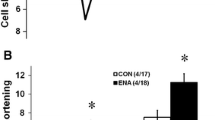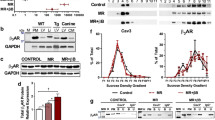Abstract
Ventricular remodeling following nonfatal myocardial infarction includes an excentric hypertrophy of the surviving myocardium, associated with hemodynamic overload. Disseminated cardiomyocyte apoptosis and phenotype changes of the surviving myocardium, such as a labile calcium homeostasis of the hypertrophied cardiomyocytes, impaired β-adrenergic signal transduction, interstitial fibrosis, and reduced coronary reserve are typical features of the overloaded, distended ventricular wall. They are considered as relevant for the myocardial dysfunction progressing to overt cardiac failure and for the enhanced mortality risk. Hemodynamic load and trophic angiotensin effects are assumed to cause this excentric hypertrophy, since systemic and local angiotensin formation in the overloaded myocardium is activated. In isolated rat cardiomyocytes, cultured on distensible membranes, overload is mimicked by distension, and causes enhanced formation and release of angiotensin II, which results in AT1 receptor mediated trophic reactions of distended neonatal cardiomyocytes and in AT1-mediated apoptosis in distended adult cardiomyocytes.
In experimental models of post-infarct remodeling, therapy with ACE inhibition or with AT1 blockade similarly normalizes myocardial hypertrophy, interstitial fibrosis, and impaired coronary reserve. In patients with terminal heart failure, a reduction of apoptotic signs and a normalization of antiapoptotic gene expression is obtained by myocardial unloading under ventricular assist devices or by treatment with ACE inhibitors, and the latter therapy has been shown to improve survival. In contrast to general assumptions and to predictions from data in vitro, the improvements obtained by AT1 blocker therapy in vivo are mediated by bradykinin, as are those obtained under ACE inhibitors. Under AT1 blockade, bradykinin is probably activated due to stimulation of AT2 and other AT receptors.
Similar content being viewed by others
Author information
Authors and Affiliations
Rights and permissions
About this article
Cite this article
Holtz, J. Role of ACE inhibition or AT1 blockade in the remodeling following myocardial infarction. Basic Res Cardiol 93 (Suppl 2), s092–s100 (1998). https://doi.org/10.1007/s003950050228
Issue Date:
DOI: https://doi.org/10.1007/s003950050228




